
Essay: Spanning our expectations; the work of building bridges
-
Back in 1966, moments before a potential government-toppling by-election in Hull North, Prime Minister Harold Wilson got his Minister of Transport, Barbara Castle, to sanction the Humber Bridge. Construction began in 1972, the bridge opened in 1981. It reduces the road distance between Hull and Grimsby by 50 miles; original cost estimate £28m, cost at completion £98m, accumulated cost, with interest by 2011, £345m. Ho-hum, bridges will empty your pockets before you can cross them.
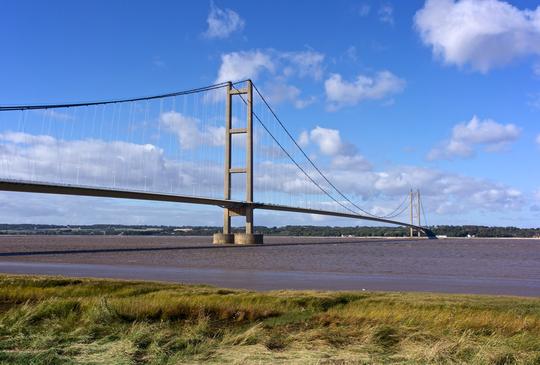
There’s a competition afoot to design a new bridge for Salford. A bridge that will span the River Irwell, connecting The Crescent, Chapel Street (the City’s main Civic drag) with The Meadows, seven hectares (17 and a bit acres) of under-used green space that is very nearly Ox-bowed by a tight curve in the river. All part of the over-arching vision for Irwell River Park, which glints more brightly in the Salford eye, than it appears to do in Manchester’s. So why kick off in Hull? Because between Salford and Hull is a veritable Festival of Bridges, because two of the very best have been designed by architects McDowell + Benedetti, and because Renato Benedetti is Chair of the competition judging panel for the Salford Meadows Bridge.
There’s a competition afoot to design a new bridge for Salford. A bridge that will span the River Irwell, connecting The Crescent, Chapel Street (the City’s main Civic drag) with The Meadows, seven hectares of under-used green space that is very nearly Ox-bowed by a tight curve in the river.
Driving East on the M62 is one of the UK’s great road journeys, partly because it terminates with views of Humber Bridge. Whatever else may have been Wilson’s motive for bringing it on, his gesture is justified on aesthetic grounds. Very few structures, in landscapes world wide, match in grace and majesty the Humber Bridge. It was, for 16 years, the longest single-span suspension bridge in the world (sustained, incredibly, by 44,000 miles of cable).
You’ve already passed beneath the exhilarating Scammonden Bridge, which carries the B6114 Saddleworth Road across the M62 west of Leeds. You know it. It’s like some great white coat hanger jammed high above the carriageway as it climbs to its highest point. As Wikipedia will confirm, this wonder of the motorway network was the biggest single-span non-suspended bridge in the world when it opened in 1970. One hundred and twenty feet above your head is, to this day, the longest single-arch concrete bridge in the UK, designed by Colonel Stewart Maynard Lovell, Royal Engineers (retired).
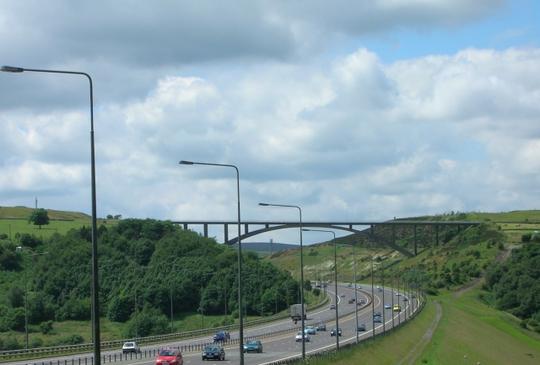
At junction 31, take the A655 to Castleford. In a little over two miles, park close to Aire Street and stroll across the Castleford Bridge, the languid inverted S boardwalk that teeters above a weir in the River Aire. Upon this, one hundred and thirty metres of ecologically sourced Brazilian hardwood at a total cost of £3.2m, much of the future for Castleford was invested. As if early millennial pressures and hot fashion for regeneration were not enough (Castleford Bridge commissioned in 2003 completed in 2008), Channel 4 poster boy Kevin McCloud hooved into view and filmed the whole damn thing.
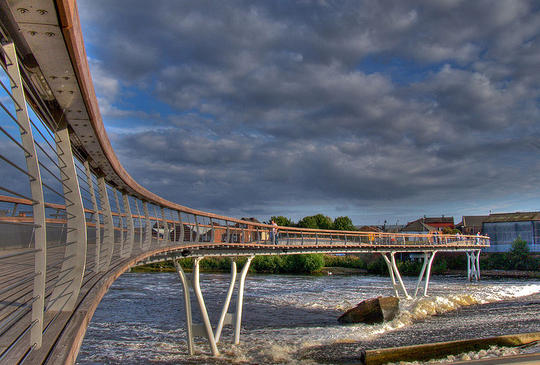
Bridges carry expectations. We identify them, list and categorise them, span eons, define, replicate, copy and grade. Ponte Vecchio, surely Prince of Bridges, Rialto, Bridge of Sighs, Tower Bridge, Brooklyn, Golden Gate, Oresund, television drama star. Bridges and bridge-builders get hyped. None more so than architect Santiago Calatrava, whose lawyers are kept at least as busy as his engineers, calculating, combating and countering the tensions produced by $4billion projects (as he is currently running at the PATH – Port Authority Trans-Hudson - station in New York). Envy being the granite characteristic embedded in the hearts of all architects, Rem Koolhaas has sneeringly characterised Calatrava’s prolific bridge-building as…”over every rivulet, a Calatrava”. The Irwell has one. We call it Trinity Bridge, and it was commissioned by Salford Council.
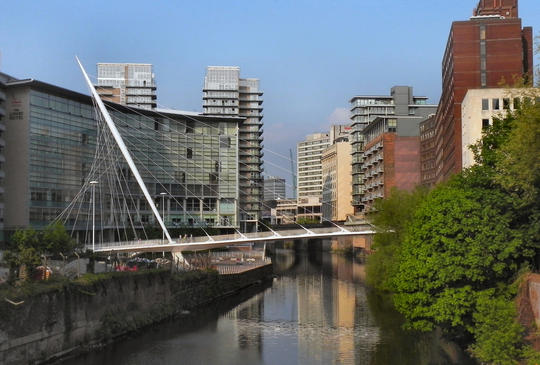
Trinity is modest Calatrava, but (once it was made to fit) it does the trick. The foot and bicycle bridge opens up Chapel Street to Deansgate, and, as importantly, it became something of a pin-up for modern Manchester (which doubtless induces paroxysms on the south bank of the Irwell). Castlefield Bridge, white, spikey, Calatravaesque, by engineers Whitby Bird allowed developer Urban Splash to better connect its developments in Hulme to the city, and even to extend the boundaries of Castlefield. The Millennium lift bridge by the Lowry at Salford Quays was joined, in 2012, by Media City Footbridge, designed by UK star bridgers, Wilkinson Eyre. These bridges are pleasingly complementary, and successfully complete a circuit that makes a visitor destination in itself.
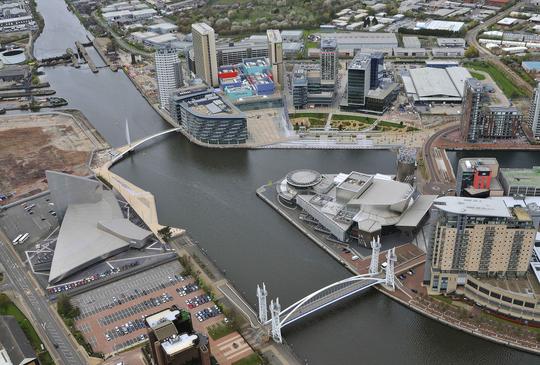
Perhaps the Irwell is one of Koolhaas’s “rivulets”, if so appearances belie significance. Listed a Grade 1 structure in both Manchester and Salford, The River Irwell Railway Bridge of 1830, by engineer George Stephenson, is the first example, anywhere in the world, of a passenger and freight line crossing a river. Before the railway Manchester had canals and their archaeology offers another layer of bridges. The Kitty footbridge Redhill Street on the Rochdale by Great Ancoats Street, that had a gent’s toilet in-built. Store Street aqueduct on the Ashton, the oldest still in use. A big new footbridge, plate-steel with cut outs, a little further up Redhill street, connecting across to Cottonfield Park, and the New Islington moorings. Two more modern bridges that launch in one city and land in the other; at Spinningfield and at Greengate. They work, these bridges, they make connections and consolidate the A’s and B’s of an imperfect world.
Two more modern bridges that launch in one city and land in the other; at Spinningfield and at Greengate. They work, these bridges, they make connections and consolidate the A’s and B’s of an imperfect world.
Onwards, into Hull old town. Down the High Street, past The Black Boy. UK City of Culture 2017, and much in need of the honour. What a place this has been. Home of William Wilberforce, the backdrop to most of Philip Larkin’s adult life. “Give me your arm, old toad…” There is a fine historic cityscape here, at the junction of the Humber and the Hull. And a remarkable new bridge at the end of Scale Lane. Shoving uncomfortable realities to one side – the bridge arrived late, in Hull the recession arrived early, the regeneration it was supposed to promote hasn’t materialised – for a bridge that goes nearly nowhere, it is mighty impressive.
Their Castleford Bridge is a slinky, elegant thing. In Scale Lane Jonathan McDowell and Renato Benedetti have introduced a formidable passenger ferry masquerading as a bridge. If you’ve seen the Torpoint chain ferry in that other heroically blitzed town, Plymouth, you’ll know what I mean. Big, black, oddly shaped, ungainly even. The River Hull is silted up on the west, Scale Lane side. The tidal and navigable channel is to the east. So the structure is like a comma, a crotchet, a pinball machine flipper, the fat end pitches into the mud on the west “hub” side, and the deck of the bridge is anchored to it, the mechanism flips it around and slightly upwards to kiss the east bank. And it does so with all aboard. A thousand people can thus span the river at a gentle stride, whilst standing still, and being piped and whistled across by the bridge’s own sound installation of birdsong, engines and bells. It is quite magical, and well worth a viewing here: http://www.thenbs.com/nbsTV/civilEngineers/programme.asp?refCode=313348&...
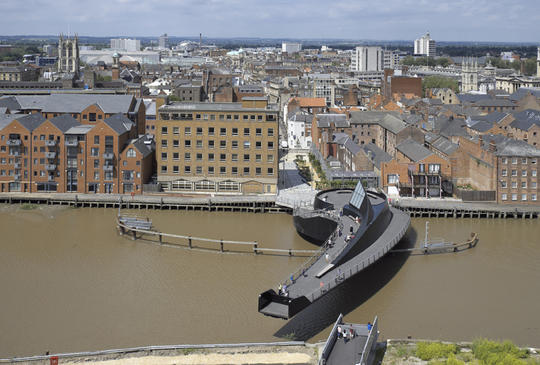
On the east bank of the River Hull is a Premier Inn and multi-storey car park. And footpath and cycle route to Terry Farrell’s The Deep. And little else. Except that some development will happen, must happen, or Scale Lane will become a symbol of the pointless. As it is, there is no operator for the inbuilt super structural café and retail space. This is what UK City of Culture 2017 can do for Hull. Get the ideas and the entrepreneurs into the empty spaces and see them prosper. Scale Lane is a place, and a unique bridge. It will work, because it is too good not to.
After the biggest entry list RIBA has had for any such competition it has run, Salford Meadows Bridge is down to a shortlist of four, and the winner to be announced in the third week of January 2014. Google it and follow links to images of some 127 schemes, good, bad and quite frightening. From commissioning of the bridge for Scale Lane to its eventual opening, for various reasons, technical, financial and administrative, was eight years. Will Salford wait that long? Renato Benedetti is upbeat about the outcome. And Salford, it must be said, is getting rather good at bridges.
Image Credits
The Humber Bridge by Angie and by Paul Buckingham, Scammonden Bridge by Ian M, Castleford-bridge by 54north, Trinity Bridge by David Dixon and Salford Quays - Media City by Stevo1000 are all licensed for reuse under this Creative Commons Licence.
Scale Lane Bridge by Timothy Soar, permission of use from McDowell & Benedetti.
Contributor Profile
Freelance writer, broadcaster and curator with special interest in architecture and urban issues. If you haven't caught if already, his TEDxManchester talk on the city's architecture is a rare treat. He's also responsible for an ongoing, and successful series of pop-up galleries.

